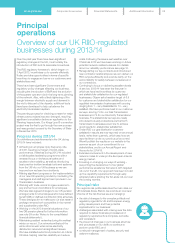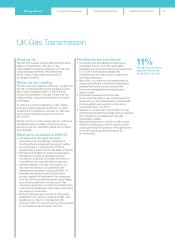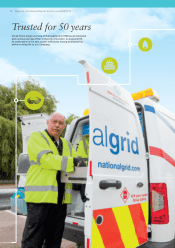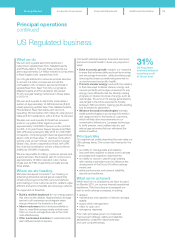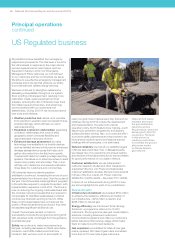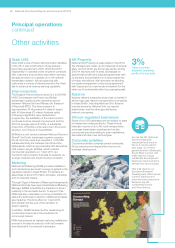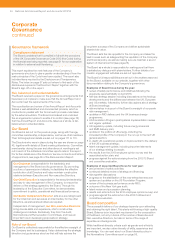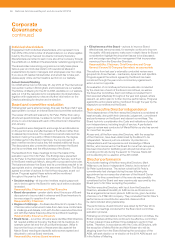National Grid 2014 Annual Report Download - page 38
Download and view the complete annual report
Please find page 38 of the 2014 National Grid annual report below. You can navigate through the pages in the report by either clicking on the pages listed below, or by using the keyword search tool below to find specific information within the annual report.
All jurisdictions have benefited from emergency
response improvements. This has been a focus for
the US business in response to the major storms
wehave experienced in recent years, such as
Superstorm Sandy in 2012. Our Emergency
Management Policy reinforces our commitment
toour customers and the communities we serve.
We strive to use effective emergency management
principles and protocols that enhance our ability
toprovide safe and reliable energy services.
We have continued to strengthen resilience by
assessing vulnerabilities throughout our system,
flood-proofing critical equipment, readying more
restoration crews, repair equipment and fuel
supplies, reducing the risk of downed power lines
from fallen trees and branches, and enhancing
communications with our customers and
stakeholders. During 2013/14 we introduced some
new tools and initiatives:
• Weather predictive tool: allows us to use data
from past storm events to learn and predict future
potential damage, which will help our storm
response planning.
• Expanded contractor relationships: expanding
contractor relationships that cover a wider
geographic area to increase flexibility and
responsiveness in any type of storm.
• Enhanced damage assessment: by using
technology now available to us (mobile devices
such as tablets) we have introduced an enhanced
damage assessment process that helps us to
gather information from the field more quickly.
Coupled with data from existing outage reporting
systems, this allows us to determine where to send
crews more quickly and accurately. This, in turn,
will help us to determine and execute restoration
times faster for customers and communities.
US enterprise resource planning system
stabilisationcontinued, remedying the errors of poor
implementation from the prior year. Over the course of
the year, the US business made significant progress
in the activities required to upgrade the system, with
implementation expected in mid-2014. The focus is
now on reducing the ongoing costs associated with
the complex manual processes that are required to
compensate for identified weaknesses in internal
controls over financial reporting in the US. While
these control weaknesses have not reduced the
quality of financial statements produced, they have
necessitated significant additional cost.
Overall, the business remains on track to
successfully conclude the programme during 2014,
with expected costs unchanged from the guidance
provided last year.
Safety: we continue to make improvements on
lastyear, including decreases in OSHA recordable
incidents, road traffic collisions and lost time
incidents. Still, we have much to accomplish to
reach our goal of zero injuries every day. Some of our
initiatives during 2013/14 include the development
and implementation of a safe motor vehicle
operation policy, Smith System driver training, a soft
tissue injury prevention programme, and slippery
surface simulator training. Also, in a continued effort
to promote safety awareness and improvement, we
have shared incident reports and lessons learned
briefings with all employees, on a daily basis.
Network reliability: we met all our reliability targets
in Rhode Island and New York. In Massachusetts,
we missed two of our electricity circuit level metrics
and avoided a financial penalty due to earned offsets
for good performance on our system metrics.
Customer satisfaction: we use independent
customer research studies and other measures to
supplement the four J.D. Power and Associates
customer satisfaction studies. We saw improvements
in three of the four overall J.D. Power customer
satisfaction quartile results – see page 10 for details.
In terms of our achievements during 2013/14, here
are some highlights from each of our jurisdictions:
Massachusetts
Infrastructure investment: we invested $510million
to enhance the resilience, efficiency and safety of
ourinfrastructure – $212 million in electric and
$298million in natural gas.
Energy efficiency: we introduced ‘Smart Energy
Solutions’, a programme rolled out to 15,000
customers. The programme uses grid modernisation
solutions, including advanced meters and
communications systems and offers our customers
better data about their energy usage, which helps
them to make more informed decisions.
Gas expansion: we installed 32 miles of new gas
mains, replaced 162 miles of gas mains and added
more than 9,700 new natural gas customers.
Principal operations
continued
US Regulated business
National Grid teams
maintain and repair
thegas distribution
networks across
RhodeIsland, where we
deliver gas to 252,000
customers. The team
inthis picture is
creating asolid base
toreinstate the ground
after some works
onRhode Island’s
gasnetwork.
36 National Grid Annual Report and Accounts 2013/14





